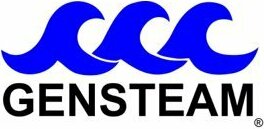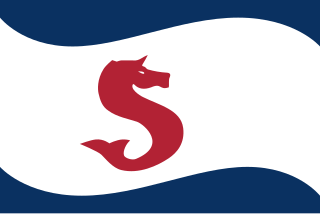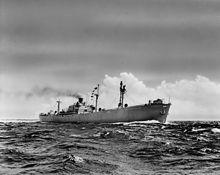Pacific Far East Line, also called PFEL in short, was a passenger and cargo shipping line founded in 1943 by Thomas E. Cuffe, in San Francisco, California. At the beginning he started by chartering foreign ships to run the lines in tramp trade. Later scheduled cargo services were added to the line. During World War II the South Atlantic steamship line was active with charter shipping with the Maritime Commission and War Shipping Administration.

General Steamship Company was founded in 1920 in Houston, Texas, United States, as a Private Company, and now goes by Gensteam since 1996. General Steamship Company has a fleet of cargo ships that operate worldwide. Gensteam has a Gensteam Operations Desk website that tracks all shipping logistics. Gensteam headquarters is now in San Francisco, California. General Steamship Company was part owner of American Pacific Steamship Company in New York state and Los Angeles during and post World War II. American Pacific Steamship Company was founded in 1942 in New York City, and was previously called Los Angeles Tanker Operators Inc. which operated T2 tanker ships. During World War II the General Steamship Company and American Pacific Steamship Company were active with charter shipping with the Maritime Commission and War Shipping Administration.

Black Diamond Steamship Company (BDSC) operated passenger and cargo liners from New York City to Rotterdam and Antwerp. It was founded by J.E. Dockendorff in 1919, and named the American Diamond Line by the United States Shipping Board. The company was profitable in the 1920s and early 1930s. Prior to the United States' entry into World War II, the nation's neutrality policy ended much of the lines trade. Dockendorff stepped down as a principal executive in 1934, selling the only one of the company's 21 ships not owned by the government: New Britain, which he had bought in 1918. During World War II the company sold most of its American Diamond Line ships and moved to charter shipping with the Maritime Commission and War Shipping Administration. During the war, the Black Diamond Steamship Company operated Victory ships and Liberty ships. These ships were operated by their own crews; the US Navy supplied United States Navy Armed Guards to man the deck guns and radio. The most common armament mounted on these merchant ships were the MK II 20mm Oerlikon autocannon and the 3"/50, 4"/50, and 5"/38 deck guns. After the war there were many surplus ships and much competition. Black Diamond Steamship Company continued to operate after the war, but finally closed in 1955.
Weyerhaeuser Steamship Company was a cargo Liner company founded in Tacoma, Washington. Weyerhaeuser Steamship Company was founded by Weyerhaeuser Company in 1933. Weyerhaeuser is one of the largest lumber and paper companies in the United States. First called the Weyerhaeuser Timber Company which started with ships for towing logs in the Northwestern United States. Weyerhaeuser started Weyerhaeuser Timber Company with a ship he acquired in 1892. The log towing ship was a 140-foot sternwheeler built for the partnership, Weyerhaeuser and Denkman Company. In 1923 Weyerhaeuser added to ocean lumber cargo ship the SS Pomona and the SS Hanley. The two ships took lumber to the East Coast. In 1933 F. Weyerhaeuser starts the Weyerhaeuser Steamship Company and moves the headquarters to Newark, New Jersey. At the outbreak of World War II the US government orders the four Weyerhaeuser to take supplies to the British army in Egypt. The next year the other four company's ships are requisitioned by the War Shipping Administration. During World War II the Weyerhaeuser Steamship Company was active in charter shipping with the Maritime Commission and War Shipping Administration. During wartime, the Weyerhaeuser Steamship Company operated Victory ships and Liberty ships. The ship was run by its crew and the US Navy supplied United States Navy Armed Guards to man the deck guns and radio. The most common armament mounted on these merchant ships were the MK II 20mm Oerlikon autocannon and the 3"/50, 4"/50, and 5"/38 deck guns. In 1942 the SS Potlatch and the SS Heffron were sunk by German U-boats torpedoes. After the war, Weyerhaeuser Steamship Company purchased four Liberty ships for intercoastal shipping service. In 1950 Weyerhaeuser Steamship Company purchases the Pacific Coast Direct Line and moves its headquarter from Newark to San Francisco. In 1962 the Weyerhaeuser Line is started and Weyerhaeuser Steamship becomes a division of Weyerhaeuser Company.

Calmar Steamship Company was a proprietary subsidiary of the Bethlehem Steel founded in New York City in 1927. Bethlehem Steel Company founded Calmar Steamship Company and other steamship companies after finding general shipping companies could not meet the company's needs in a timely manner. At the time Bethlehem Steel Company was the second-largest steelmaker in the United States and the world, only behind U.S. Steel. Calmar Steamship Company shipped Bethlehem Steel Company products from the Atlantic coast to the Pacific coast. On the return trip, Calmar Steamship Company would bring lumber products from the Pacific coast to the Atlantic coast. Calmar Steamship Company closed in 1976, as United States steel manufacture declined in the 1960s.

Interocean Shipping Company, Interocean Steamship Company of San Francisco was a subsidiary of the Bethlehem Steel Company founded in the late 1930s and closed in 1986.

States Steamship Company, also called States Line and SSS, was started in 1928 by Charles Dant, in Portland, Oregon and later moved to the headquarters to San Francisco. Dant started the States Steamship Company to take his lumber product to market. He had a fleet of lumber schooners. Dant started by leasing ships from the United States Shipping Board - Emergency Fleet Corporation and founded the Columbia Pacific Steamship Company in 1919, Columbia Pacific Steamship Company routes were between Portland, Far East and Europe. In 1928 Dant merged the Columbia Pacific Steamship Company into the States Steamship Company. The Europe route ended in 1932 and the ship moved to a Philippines route. With the shift to container shipping in the 1960s and Dant's fleet of ships becoming older and obsolete, the company into bankruptcy in 1979. States Line operated four subsidies: Pacific-Atlantic Steamship Company, California Eastern Line founded in 1937 for lumber shipping, Oregon Oriental Line and the Quaker Line.

Merchants and Miners Transportation Company, often called M&M and Queen of Sea, was a major cargo and passenger shipping company founded in 1852 in Baltimore, Maryland. In 1852 is started with routes from Baltimore and Boston two wooden side wheelers ships. In 1859 M&M added two iron hulled steamers to its fleet. In 1866, post Civil War, M&M added routes to Providence, Rhode Island, Norfolk and Savannah, Georgia. In 1876 M&M purchased the Baltimore & Savannah Steamship Company add routes to Savannah, Jacksonville and Charleston. In 1907 the Winsor Line of Philadelphia's J. S. Winslow & Company of Portland, Maine was purchased, with seven steamships. The Winsor Line was founded in 1884 by J. S. Winslow. The Winsor Line first route was from Norfolk, Virginia to New England ports, supplying West Virginia coal. The Winsor Line sailing ship Addie M. Lawrence took ammunition to Europe during World War I. By World War II M&M had a fleet of 18 ships and add routes to Miami. With the outbreak of World War II the War Shipping Administration requisitioned Merchants and Miners Transportation Company fleet of ships for the war effort.

Blidberg Rothchild Company was a shipping company founded by Allan Blidberg and Sylvester Rothschild in New York City, United States. The shipping company has is start with a previous company Blidberg and Sagen Company founded by Tryggve Sagen and Allan Blidberg. Tryggve Sagen owned a ship in Oslo, Norway before coming to the United States in 1919. Sylvester Rothschild was born in 1896 in Sweden, he was a finance officer in Gothenburg. Rothschild came to the US in 1919 and started the shipping company with Sagen. Blidberg and Sagen Company had shipping routes from New York to Scandinavian and Baltic ports. Sagen was president, Blidberg vice president and Sylvester Rothschild was the Secretary for the shipping company. Sylvester Rothschild was from Gothenburg, Sweden, where he was the vice-consul. In the 1930s Tryggve Sagen departed the company and the firm was renamed Blidberg Rothchild Company. The company had offices in Gothenburg and Norway. Blidberg Rothchild Company worked with an affiliated company Eastport Steamship Co of New York. Blidberg Rothchild Company also worked with an affiliated company, Bridgeport Steamship Line of New York, a New Haven Railroad company.
North Atlantic & Gulf Steamship Company was founded in New York City on February 13, 1932, by George V. Reilly, William M. Stevens, and David H. Jackman. The president of North Atlantic & Gulf Steamship Company in 1932 was Charles Walter Ulsh. North Atlantic & Gulf Steamship Company's treasurer and vice president was Clifton Waller Barrett. Charles Walter Ulsh and Clifton Waller Barrett founded the ship broker firm Ulsh & Barrett. Charles Walter Ulsh invited and patented a skid platform pallet for shipping. His United States patent #US1934389A is used for a stackable and nested skid platform.
Parry Navigation Company was a shipping company founded in 1942 by Alfred Walter Parry Jr. in New York City. Alfred Walter Parry Jr. first career was ship broker with Smith & Terry Inc. in New York City. He was also the office manager of the Interocean Steamship Company of New York in New Orleans. Smith & Terry Inc also were managing agents for the some United States Shipping Board ships. Alfred Walter Parry Jr. father, Alfred Walter Parry, Sr., was an agent for a railroad company. Parry Navigation Company operated ships for the World War II. Alfred Walter Parry Jr. became a Colonel in the United States Army. Parry served with the US Army Transportation Corps in the South Pacific Ocean. Parry Navigation Company expanded the company and opened an office in San Francisco in 1945. Parry Navigation Company stated the Parry Line in 1947 and expanded with route to Galveston, Texas. The Parry Line had routes from the West Coast of the United States to Manila, Shanghai, Hong Kong and North China. Parry was the vice president for the Lykes Brothers Steamship Company for a few years. Parry was awarded the Legion of Merit and World War II Victory Medal for his service in the US Army Transportation Corps. Charles W. Perkes was a manager in Parry Navigation Company. Perkes, before Parry worked for the Dollar Line.
Polarus Steamship Company was founded in 1918, and again in 1923 in New York City by Tikhon Nicholas Agapeyeff (1891–1931). Tikhon N. Agapeyeff's 1918 frim, operated for only about two years. In March 1921, Agapeyeff sold the first Polarus Steamship Company to the C. M. Fetterolf Company for $250,000. The next incorporation in 1923 was a partnership of Agapeyeff, Marcel Levy, and Charles S. Dunaif. Marcel Levy was an attorney and Charles S. Dunaif was an exporter.

Pope & Talbot, Inc. was a lumber company and shipping company founded by Andrew Jackson Pope and Frederic Talbot in 1849 in San Francisco, California. Pope and Talbot came to California in 1849 from East Machias, Maine. Pope & Talbot lumber company was very successful, with the high demand of the 1849 Gold Rush.
American Foreign Steamship Corporation was founded in Brooklyn, New York City, in 1932 by Ira L. Rosenson, Sophia Pruss and Elias Katz. Rosenson was an attorney and the major shareholder in the firm. American Foreign Steamship Corporation purchased a 5,570-ton cargo ship SS Eastern Glen from the American South African Line in 1933. American Foreign Steamship Corporation named the ship the SS American Oriole. The ship was built by Kabushiki Kaisha Uchida Zosengo company of Yokohama, Japan, in 1920. The ship was a United States Shipping Board ship. The next two ships purchased was the SS Liberty Glo and SS Wildwood, these were Hog Islanders type ships. The two ships were purchased from the South Atlantic Steamship Company. In 1938 another Hog Islanders ship was purchased the, SS Magmeric, renamed the SS American Robin. The American Oriole was sold to England in 1940 to help with the World War II efforts. She was renamed the SS Barberrys, but on November 26, 1942, she was sunk by a torpedoed from German submarine U-663 off of St. John's, Newfoundland.
De La Rama Steamship Company, Inc. was a shipping company founded in New York City by the Isidro de la Rama family in 1930. Isidro de la Rama family founded the De La Rama Steamship Company to export sugar from their large his sugar plantations in the Philippines. Isidro de la Rama was also commissioned by the United States Army to be a blockade runner to bring supplies, such as food and ammunition, to the United States Army and Philippine Army after the invasion of Empire of Japan into the Philippines.
Dichmann, Wright & Pugh, Inc. was a shipping company founded in Norfolk, Virginia in 1925 by Vilh Dichmann, Bland Saunders Wright, Frank C. Pugh, Clint B. Sellers, and Alan Smith. Pugh had operated a company office in Philadelphia. Clint B. Sellers operated a company office in New York City. Saunders Wright was Dichmann, Wright & Pugh, Inc. President. Alan Smith was the company secretary and treasurer. Bland Saunders Wright worked in the Dichmann, Wright & Pugh, Inc. headquarters in Norfolk until his death on October 16, 1944. After Wright death, Alan Smith became president of Dichmann, Wright & Pugh, Inc and John M. Levick became assistant secretary and treasurer. With the start of World War II Dichmann, Wright & Pugh, Inc. supported the war effort.
Prudential Steamship Corporation was a shipping company founded in 1933 in New York City by Stephan Stephanidis. Prudential Steamship Corporation operated the Prudential Lines. Prudential Lines main routes was from the United States to Mediterranean ports. The Prudential Lines was never successful and was always near bankruptcy. Prudential Lines was active in supporting the World War II efforts. At its peak in the 1960s Prudential Lines owned and operated two tankers, and five cargo ships. In 1960 the Prudential Steamship Corporation was sold to Spyros Skouras and his family. In 1969 the Prudential Lines merged with Grace Lines, which continued to operate the fleet as the Prudential Grace Line.
William J. Rountree Company was a steamship agent and broker company founded by William J. Rountree in New York City in 1912. William J. Rountree Company was active in supporting the World War II effort by chartering and operating Liberty ships and Victory ships.
T. J. Stevenson & Company, Inc. was a shipping firm founded in New York City by Thomas J. Stevenson on December 2, 1935. In 1920 Thomas J. Stevenson started working as a ship broker in New York City. Thomas J. Stevenson's father Henery Stevenson worked as a clerk at a shipping firm in New York City starting in 1910. T. J. Stevenson & Company supported the World War II effort by operating United States owned ships. After the war T. J. Stevenson & Company purchased surplus war cargo ships. Thomas J. Stevenson was born in 1892 and died on January 28, 1968.
R. A. Nicol & Company was a shipping and ship broker company founded in New York City by Robert Alexander Nicol in 1923. Robert Alexander Nicol was born in England in 1880. Robert Alexander Nicol came to the United States in 1906 at the age of 26, from Liverpool, England. In 1290 Robert Alexander Nicol became a naturalized United States citizen. He started in the shipping business by working for the Oriental Navigation Company in New York City in 1916. R. A. Nicol & Company's office was at 17 Battery Place, New York City. R. A. Nicol & Company supported the World War II effort by operating United States owned ships.










